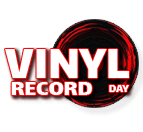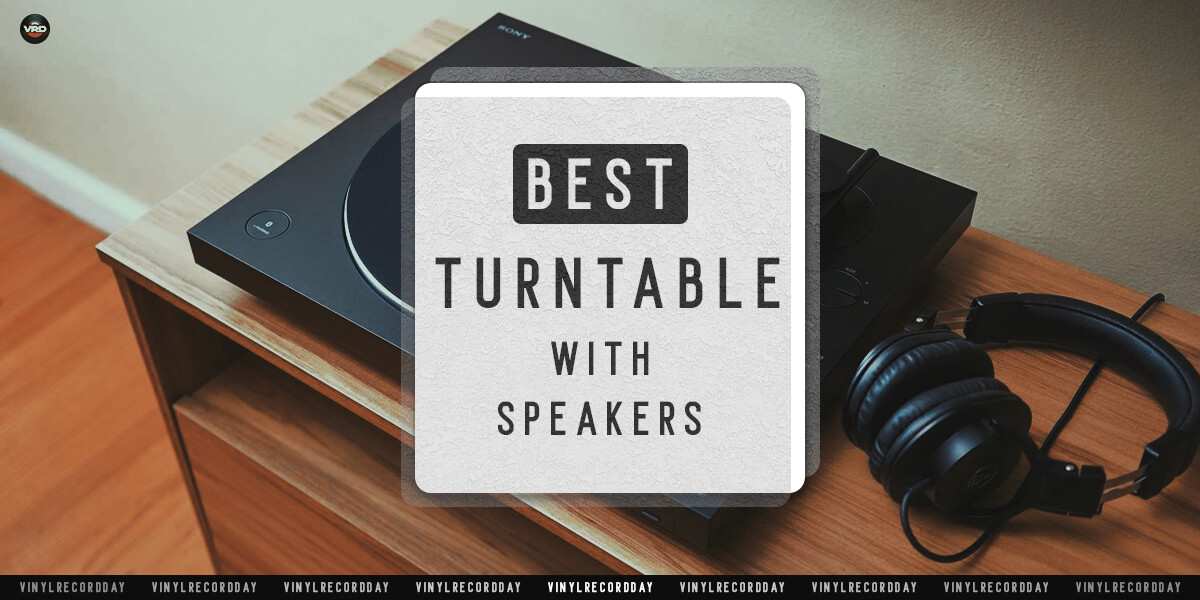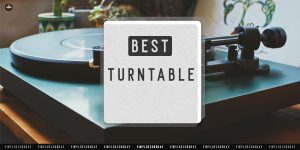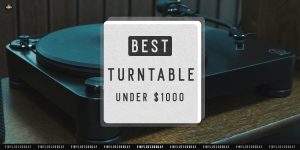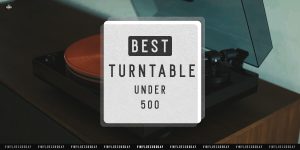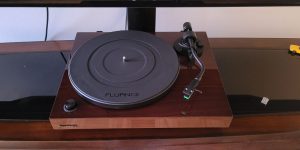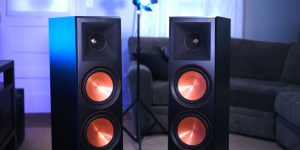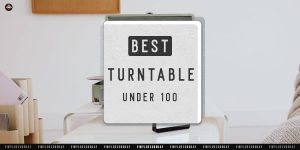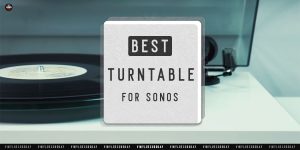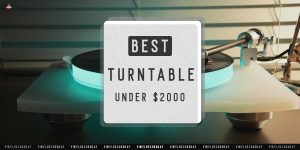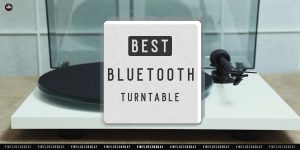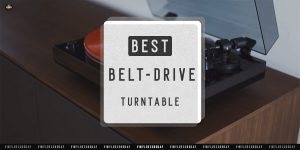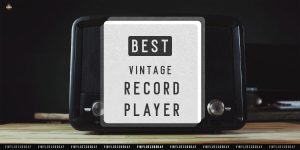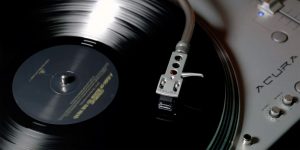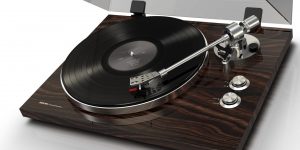Planning to discover or rediscover the world of vinyl but don’t want to spend an arm and leg to buy a sophisticated setup? Then it would be wise to invest in a record player with speakers. However, choosing a quality model is vital since poor speakers will totally ruin your listening experience.
To make your life easier, I’ve prepared a list of the best record players with speakers the market has to offer. We’ll review both types of systems – turntables with external and built-in speakers so that you can pick the most suitable one for your home. Interested? Then let’s dive in!
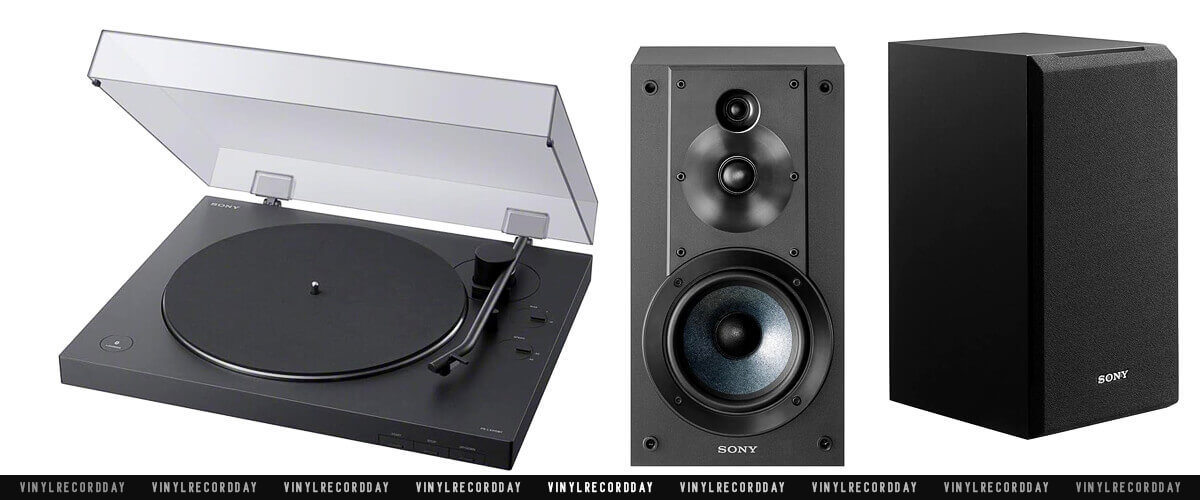
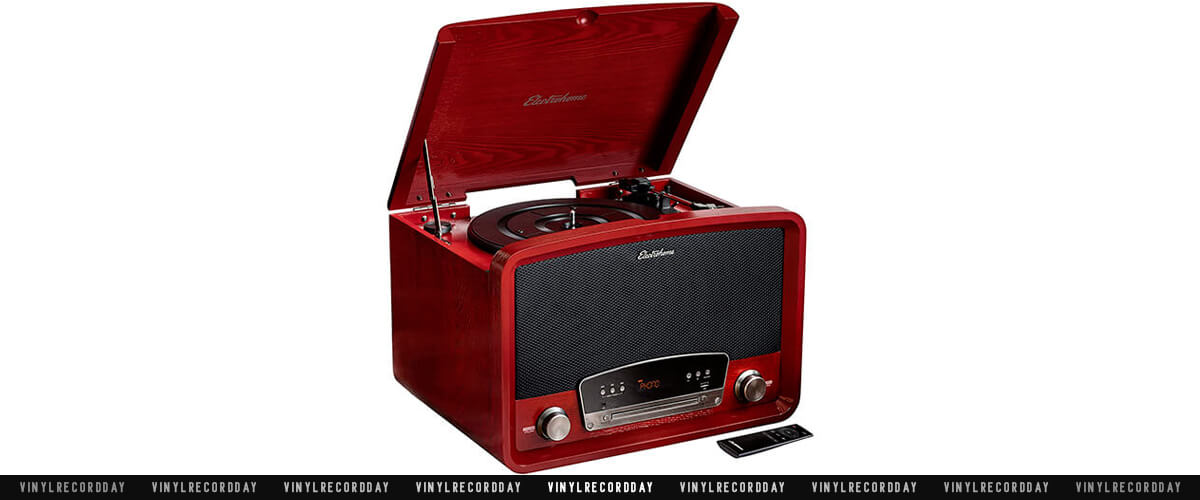
Record players with speakers comparison table
| Name | Speakers power | Speeds | Bluetooth | USB | AUX | Review |
|---|---|---|---|---|---|---|
| Sony PS-LX310BT with SSCS5 with speakers | 100 W | 33 1/3, 45 RPM | yes | yes | no | Review |
| Crosley KT100BT also great | 30 W | 33 1/3, 45 RPM | yes | no | no | Review |
| Electrohome Kingston 7-in-1 with built-in speakers | 30 W | 33 1/3, 45, 78 RPM | yes | yes | yes | Review |
| 1byone H009 budget | 36 W | 33 1/3, 45 RPM | yes | yes | yes | Review |
How I tested record players with speakers
I’ve chosen the following records from several genres of music to test the turntable’s sound with speakers:
- Fleetwood Mac – Rumours [1977]
- Michael Jackson – Thriller [1982]
- John Williams – Jurassic Park [1993]
- Leonard Cohen – Popular Problems [2014]
- Pink Floyd – Dark Side of the Moon [1973]
- Four Tet – Sixteen Oceans [2020]
Best record players with speakers reviews
Best record players with separate speakers
Both systems with separate and built-in dynamics have their own pros and cons. However, if you have a good ear for quality, you definitely need a record player with external speakers.
Here are the pros and cons of such a model:
Pros
- It produces fewer vibrations since there are no speakers incorporated into the turntable body.
- A needle reads records with much higher precision, delivering much better sound quality compared to record players with built-in speakers.
- The quality of other components is substantially higher because there are no integrated amplifiers or speakers that require a portion of the production money.
- You can upgrade your stereo system any time you want by simply hooking up more powerful speakers, external phono preamp, or amplifier.
Cons
- Higher price tag.
- Requires more space.
- Is not easily portable.
Good news: in this review, I’ve consolidated record players with powered external speakers so that you don’t need to buy a separate amplifier.
Sony PS-LX310BT with SSCS5 – best record player with speakers

In the landscape of mid-range audio gear, the Sony PS-LX310BT turntable, when paired with the SSCS5 speakers, emerges as a noteworthy choice for those venturing into the world of vinyl. As a professional musician, I’ve experienced a myriad of setups, and this combination optimally brings together practicality with commendable sound quality
The PS-LX310BT’s easy one-step operation is a boon for vinyl enthusiasts of any level. No more manual arm placement – drop a classic LP like “Dark Side of the Moon” and watch it flawlessly start. Shifting between its two speeds, I took some older jazz 45s out for a spin, and the seamless transition is a testament to its versatility. But what genuinely caught my ear? The built-in switchable phono output. Whether you’re aiming for that raw vinyl sound or a more refined tone, the three gain settings have you covered. As someone who’s always on the move, the USB ripping feature is a gem. Imagine converting your prized vinyl collections into MP3s, ensuring that Miles Davis or Ella Fitzgerald accompanies you during commutes!
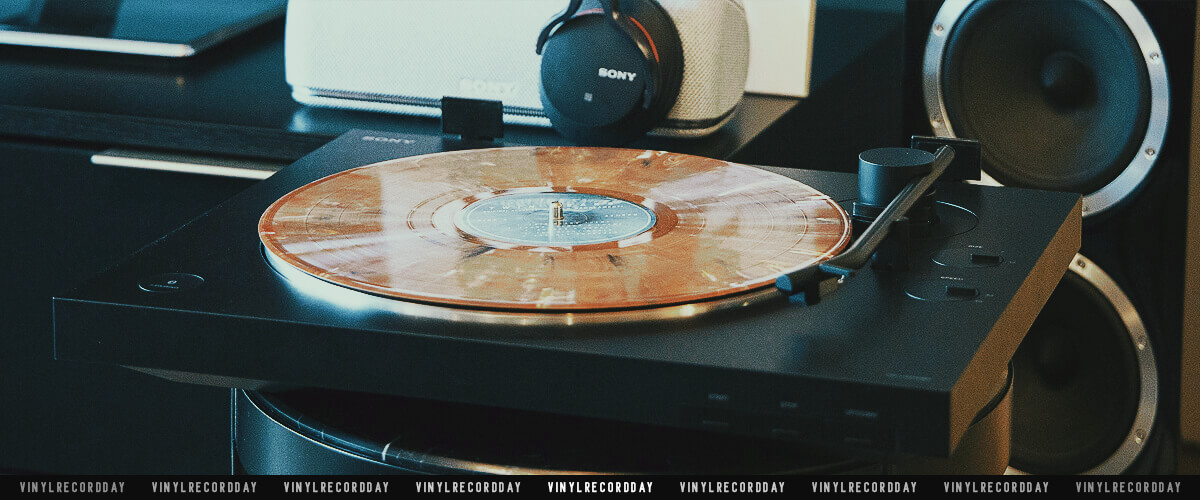
Are there any drawbacks? Yes. The PS-LX310BT reminds me of those movie sets where everything looks fabulous until you actually touch it. The buttons feel like props – light, plasticky and cheap. Every time I press one, the whole unit wobbles. Clearly, this is Sony’s way of keeping our wallets happy.
But let me tell you, in the looks department, this turntable could win beauty pageants. It’s a beautiful paradox—visually, the TT whispers luxury and elegance, while the tactile experience is more of a polite, cost-saving nod.
Now, let’s talk about the speakers. Their three-way system shines, especially when playing intricate musical tracks. Thanks to the ¾ inch super tweeter, you’ll hear crisp high frequencies, capturing the subtleties of instruments like cymbals and high hats. The 5.12-inch woofer, on the other hand, delivers pronounced bass and rich mid-tones, bringing depth to every song. Combined with the turntable, it replicates the feeling of hosting a live studio session right in your home.
If you’re searching for the best record player with speakers, the PS-LX310BT and SSCS5 duo offers a balanced blend of user-friendly features and sound quality. Sony’s pairing bridges the nostalgic charm of vinyl with contemporary audio technology, enriching your listening experience at a commendable value.
Key specs
- Drive type: belt.
- Operation type: fully-manual.
- Speeds, RPM: 33 1/3, 45.
- Cartridge: Sony MM cartridge.
- Speakers power, W: 100.
- Built-in preamp: yes.
- Bluetooth: no.
- USB: yes.
- AUX: no.
Pros
- Provides a sound quality comparable to higher-end models but at a fraction of the price.
- The smooth operation of automatic functions with no jerks – the tone arm raises and lowers with damped precision.
- Comes with a built-in preamp, providing flexibility in connection options.
- Reliable Playback – reduces the occurrence of skipping.
- Straightforward setup.
Cons
- Limited to using only the cartridge it comes with.
- AC output cables are not detachable.
- Lightweight design and cheap buttons, though it doesn’t influence the sound quality.
Turntable:
Speakers:
Crosley KT100BT – also great
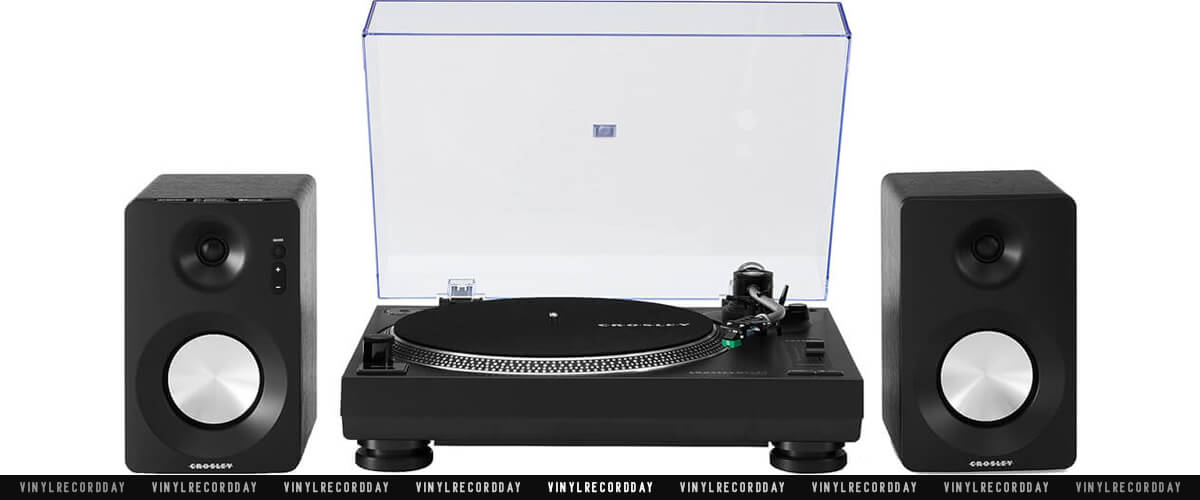
The Crosley 100BT turntable with speakers promises to bring your vinyl collection to life without breaking the bank. But does it hit the right notes? Let’s see.
The TT plays both 33 1/3 and 45 RPM records. The 12-inch slipmat and 45 adapter are thoughtful inclusions, making it welcoming to a variety of LPs. Setting the player up was quite easy.
But let’s talk brass tacks. The aluminum strobe platter and adjustable pitch control are where Crosley tries to flex its muscles. They aim for precision, and while they mostly hit the mark, it’s not without a hitch. I noticed a slight lag in achieving the desired speed – a pitch control at “0” wasn’t quite cutting it. It’s a hiccup, but nothing a little manual tweaking can’t fix.
The next thing I didn’t like was the tonearm clip – it’s awkwardly snuggled too close to the cue
lever. Each time I tried to secure the tonearm, it was like playing a mini-game of precision – often ending up locking the clip unintentionally. It can be really annoying, especially when you’re trying to treat your records with care.
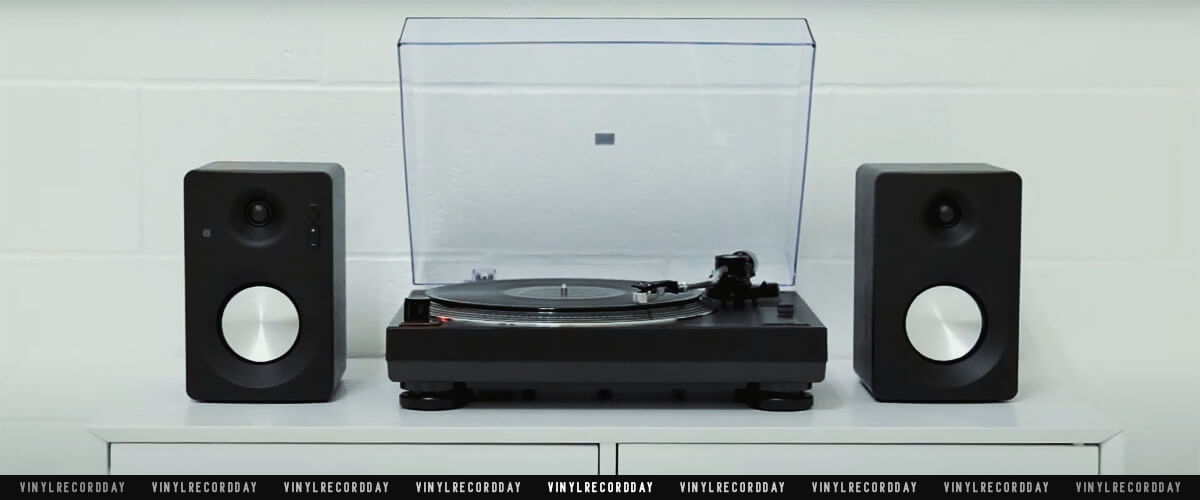
Then there’s the panel for the RCA connectors, which felt too delicate. It’s these little tactile nuances that, while not ruining the experience, certainly made it feel like the turntable needs a bit more finesse and careful handling.
Discussing the sound quality of the 100BT, the included Audio-Technica cartridge is a reasonable starting point. However, it definitely will not impress those with a more discerning ear. The clarity is there, but it lacks a certain depth, resulting in a “thin” sound. This became quite apparent when I played classic jazz albums. For instance, while Miles Davis’ intricate trumpet melodies were audible, they missed that deep, resonant quality. The music’s soulful essence just wasn’t fully captured, making the overall listening experience satisfactory but not exceptional. The speakers, though? They pack a decent punch for their size. And, of course, Bluetooth connectivity adds a modern touch.
When comparing Sony and Crosley combos, the former’s superior sound quality and user-friendly features, including one-step operation, switchable phono output, and USB ripping, clearly set it apart. The latter is a fair entry-level option, while Sony’s model represents the upgrade you’d aim for.
In summary, the Crosley 100BT is a solid, budget-friendly choice. While it requires some manual tweaking, and the sound quality may lack depth, it’s a decent starting point for newcomers, offering clear sound and convenient features like Bluetooth connectivity.
Key specs
- Drive type: belt.
- Operation type: fully-manual.
- Speeds, RPM: 33 1/3, 45.
- Cartridge: Audio-Technica MM cartridge.
- Speakers power, W: 30.
- Built-in preamp: yes.
- Bluetooth: yes.
- USB: no.
- AUX: no.
Pros
- The low-vibration synchronous motor and resonance-dampening feet are intended to minimize interference, ensuring smoother playback.
- The Bluetooth full-range bookshelf speakers with 30W RMS per speaker and a frequency response of 40Hz-20KHz are significant for a mid-range turntable, offering decent sound quality.
Cons
- Speed may need tweaking for optimal performance.
- Sound lacks depth.
- Issues with tonearm clip placement and delicate RCA connector panel.
Fluance RT81 with Ai41 bookshelf speakers
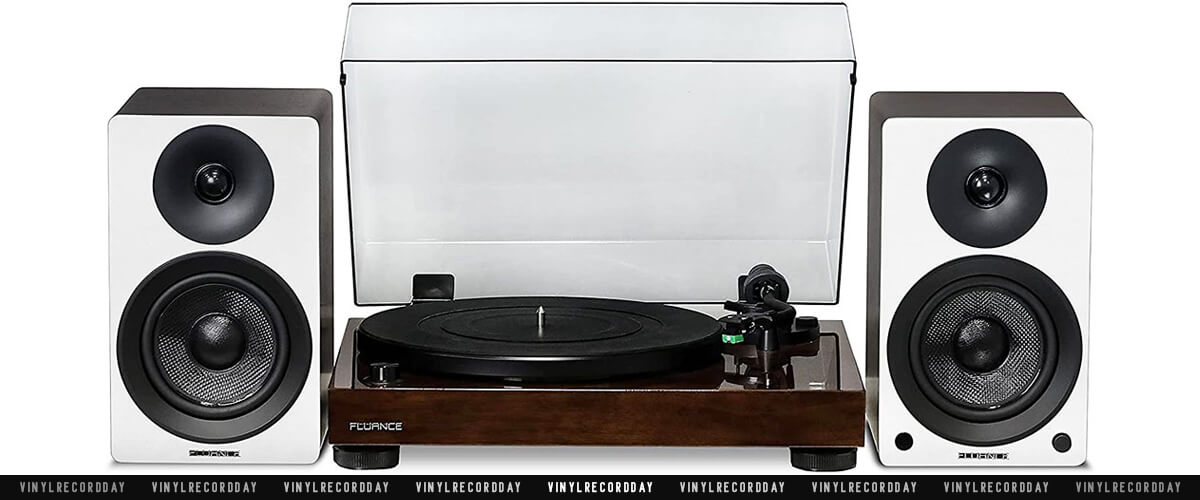
Fluance RT81 turntable and Ai41 bookshelf speakers make a fair mid-range combo that delivers a good, room-filling sound. However, let’s take a closer look at their features.
It’s the turntable that shines in this setup. High-quality components found in the RT81 stand in line with even our top-list equipment – Sony PS-LX310BT with SSCS5 and Crosley 100BT. The integrated Audio Technica ATN95E elliptical diamond-tipped stylus is known for its noiseless and distortion-free performance and clarity on melodic peaks and channel balance. In addition, gold-plated RCA line outputs produce signal transparency, while top-class Texas instruments’ phono-preamp provides high-fidelity audio.
The RT81, encased in its dense MDF body, sits on vibration-resistant legs topped with aluminum support discs. Fluance touts this structure for minimizing vibration and enhancing the “stereo panorama.” However, when you actually touch the player, the cabinet feels less robust than it looks. Moreover, balancing it becomes a bit of a delicate task – that’s what I don’t like about this TT. However, despite these nuances, the audio quality it delivers is quite decent.
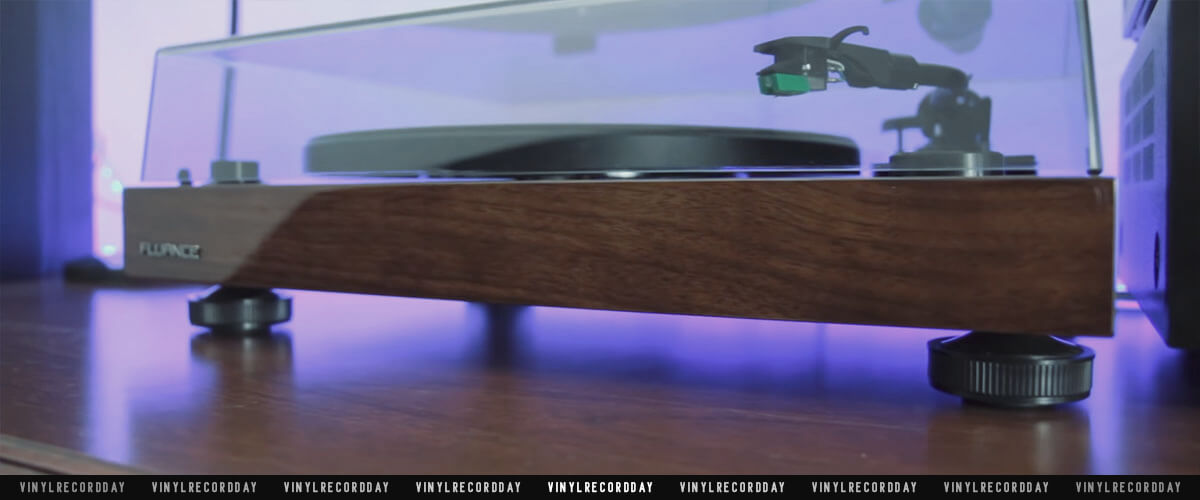
In general, this turntable is not worse than the previous two. So, why does it take the third place on the list? Because, in my opinion, the speakers don’t quite live up to the high expectations set by the manufacturer. There’s a persistent hiss, sneaky yet audible, especially when the music softens. And the sound quality, while not terrible, doesn’t quite soar to those lofty “audiophile” heights. You’ve got DSP, a beefy 90W amplifier, and yet, the sound lacks that rich, immersive depth. On the other hand, if you are not spoilt with top-of-the-line equipment, these speakers will be just fine as a starter point.
Finally, the setup has Bluetooth connectivity, designed to eliminate cabling problems. So, it’s possible to take your tunes everywhere you go!
In summary, the Fluance RT81 and Ai41 speakers offer a solid mid-range choice for vinyl newcomers. The turntable is well-equipped, though it demands careful handling, and the speakers provide adequate sound, suitable for everyday listening.
Key specs
- Drive type: belt.
- Operation type: fully-manual.
- Speeds, RPM: 33 1/3, 45.
- Speakers power, W: 90.
- Cartridge: Audio-Technica AT-95E cartridge.
- Built-in preamp: yes.
- Bluetooth: no.
- USB: no.
- AUX: no.
Pros
- Beautiful design.
- The TT is packed with high-quality components.
- Satisfactory sound.
- Doesn’t require a separate amp.
- Has a dust cover.
Cons
- The cabinet doesn’t seem solid.
- Some users complain that it may be challenging to balance the TT.
- Lower-end speakers.
1byone H004
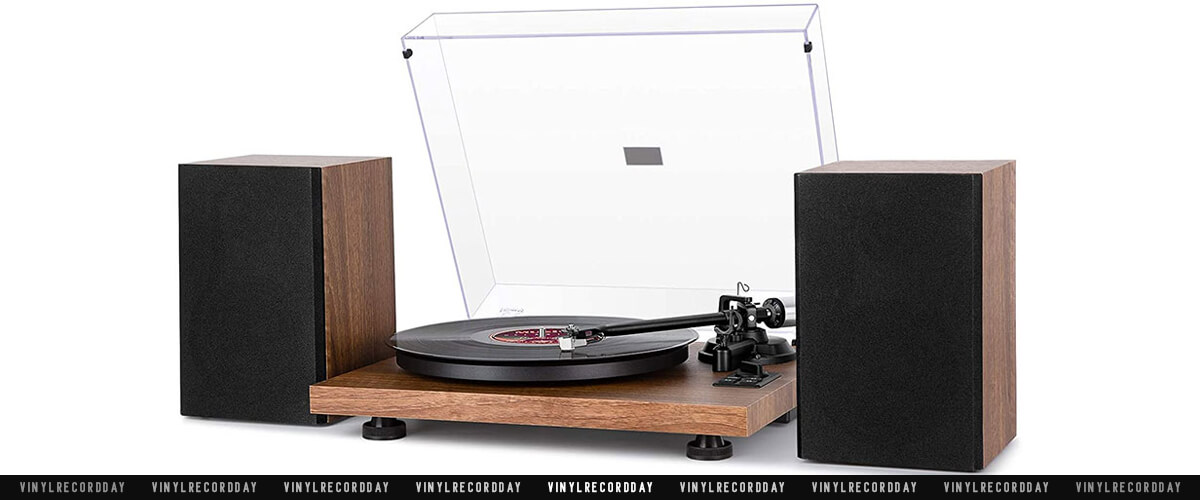
The 1byone H004 is an inexpensive Bluetooth record player with speakers that offers a bunch of user-friendly features – that’s the reason why I included it in my list. First off, the player has an onboard phono stage, USB output, and analog line output for connecting external devices.
You can easily choose between 33 1/3 or 45 RPM speeds with a speed dial on the right side of the machine. Next, the belt-drive system damps vibrations, ensuring that they don’t ruin your records or output sound quality. Plus, a precision-manufactured robust iron platter creates homogenous inertial mass for good stability and rotation.
The static-balanced tonearm comes equipped with an adjustable counterweight and Audio-Technica AT3600L MM cartridge and needle that produce warm and rich analog sound. You can easily upgrade the cartridge in the future if you want to experiment with sound quality.
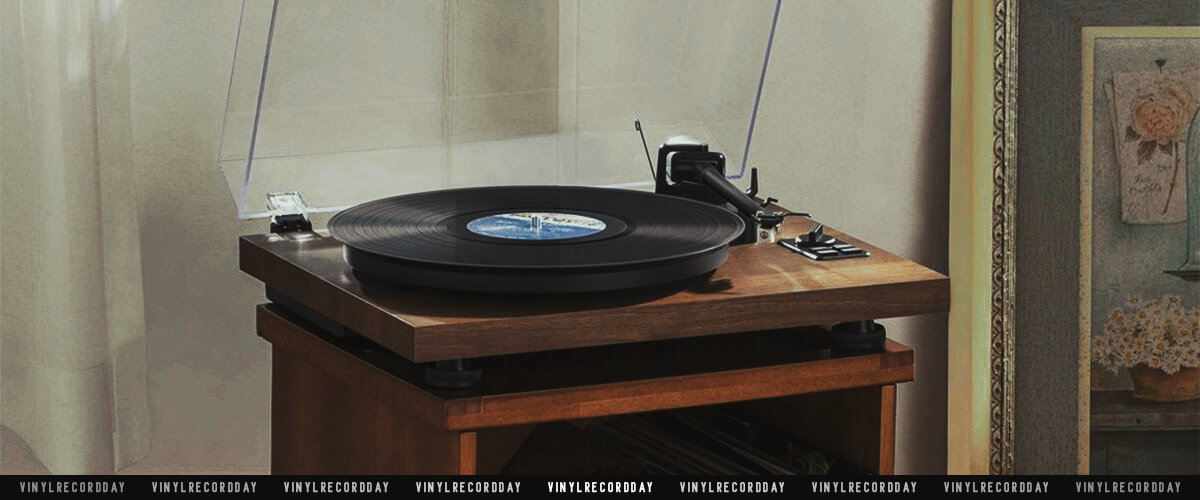
Are there any downsides? Sure, after all, it’s a lower-end system. If you are a beginner, setting it up will be your first hurdle – it’s not the kind of equipment you can just plug in and start enjoying. It requires some patience and finesse to get everything dialed in just right. Then there’s this peculiar habit of the TT: it randomly decides to shut off. Quite annoying, to be honest!
The speakers, well, they are pretty average – typical small, inexpensive bookshelf speakers you’d expect at this price point. Handling mids and highs is within their wheelhouse, but bass? Practically non-existent. If you’re a fan of deep, thumping bass lines, these speakers will leave you wanting.
And there’s a rather odd issue with the built-in digital pop-filter. During quieter passages of music, it seems to get confused, thinking the soft sounds are noise and cutting them off. This results in a digital skipping noise that’s quite jarring.
In general, the 1byone H004 is a good turntable with speakers, it’s not short on accessories & extras. However, be prepared to invest more time, patience, and possibly money if the bass is a must-have in your audio experience.
Key specs
- Drive type: belt.
- Operation type: fully-manual.
- Speeds, RPM: 33 1/3, 45.
- Speakers power, W: 36.
- Cartridge: Audio-Technica MM cartridge.
- Built-in preamp: yes.
- Bluetooth: yes.
- USB: yes.
- AUX: no.
Pros
- Well-built, wooden record player.
- Astonishing music quality – feel the bass in the air.
- User-friendly Bluetooth feature.
- The USB output for saving analog record collections digitally in CD quality.
Cons
- May randomly turn off.
- Takes time to set up.
- Weak speakers.
Best record players with built-in speakers
Although record players with separate speakers produce better sound, there may be a few reasons why you might want to buy the one with built-in dynamics. For instance, you are a beginner and don’t want to ruin your family budget to buy a high-end turntable.
For this review, I handpicked only quality models from well-trusted brands, but anyway, look at their pros and cons to understand whether you should consider such a product.
Pros
- Affordable.
- Easy to use.
- Less wiring.
- Compact and portable.
Cons
- Poorer sound quality compared to record players with separate speakers.
- The ability to upgrade a turntable with incorporated dynamics is limited.
Electrohome Kingston 7-in-1 – best with built-in speakers

Electrohome has been in business since 1907. This company creates sound systems with a retro look and modern functionality. The Kingston 7-in-1 is no exception – this solution is perfect for those who want literally everything in one package. By the way, the “package” is really beautiful. The system boasts a hand-crafted wooden cabinet, which looks very classy and fits nicely with mid-century furniture. The manufacturer claims that the chassis is acoustically tuned to isolate vibrations and prevent sound degradation. And that’s true – the player didn’t wobble during my testing. However, it’s very heavy – I wanted to move it and could barely do this. It doesn’t feel like a cheap toy.
This all-in-one solution is a perfect home stereo setup for both newbies and longtime vinyl lovers.
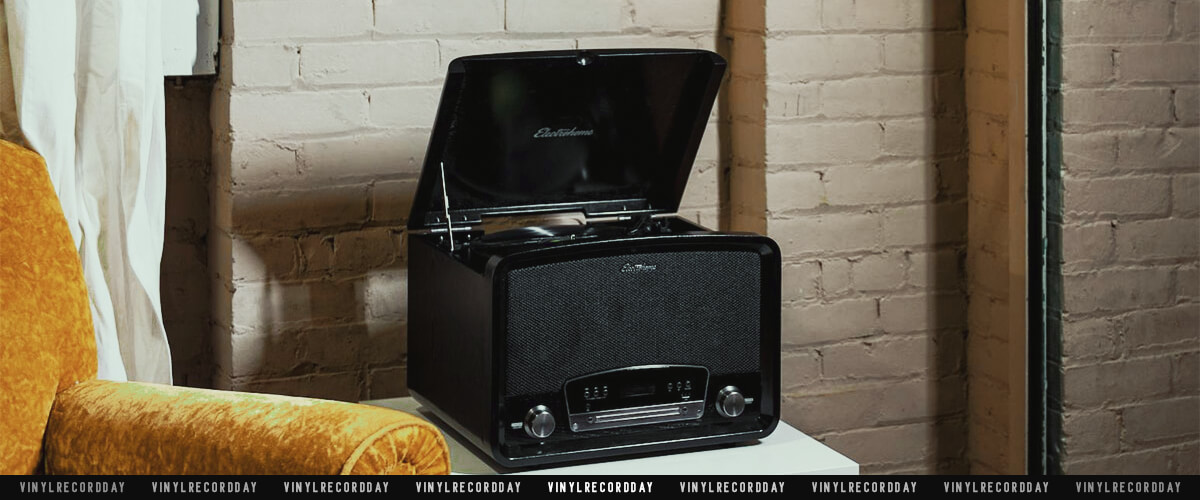
This belt-drive phonograph has a mediocre sapphire stylus and 4 speakers. The sound is ok but not powerful. So if you like it loud, you’ll need to hook up external dynamics. Luckily, the player provides such an opportunity. Further, you can play any of your records at 33, 45, or 78 RPM.
The system gives plenty of flexibility, allowing you to listen to the radio or stream your vinyl music library to any Bluetooth-enabled equipment. Plus, you can easily convert your LPs and CDs into MP files for use on USB or SD card media gadgets.
Electrohome Kingston 7-in-1 is the best record player with built-in speakers. It outperforms its competitors in a similar price range (e.g., 1byone H009) due to its 100% modern features, 3-speed design, and beautiful retro style. If you’re looking for such characteristics, you’ll never regret this purchase!
Key specs
- Drive type: belt.
- Operation type: semi-automatic.
- Speakers power, W: 30.
- Speeds, RPM: 33 1/3, 45, 78.
- Bluetooth: yes.
- USB: yes.
- AUX: yes.
Key specs
- Drive type: belt.
- Operation type: semi-automatic.
- Speeds, RPM: 33 1/3, 45, 78.
- Speakers power, W: 30.
- Cartridge: ceramic with sapphire tipped stylus.
- Built-in preamp: yes.
- Bluetooth: yes.
- USB: yes.
- AUX: yes.
Pros
- Lovely classic look.
- The benefit of having a wide range of playback alternatives.
- 4 high-performance speakers with warm acoustics.
- A great equalizer that boosts bass and treble.
- Easy to get up and running.
Cons
- Those who enjoy loud music may require extra speakers.
- Poor stylus.
1byone H009 – budget
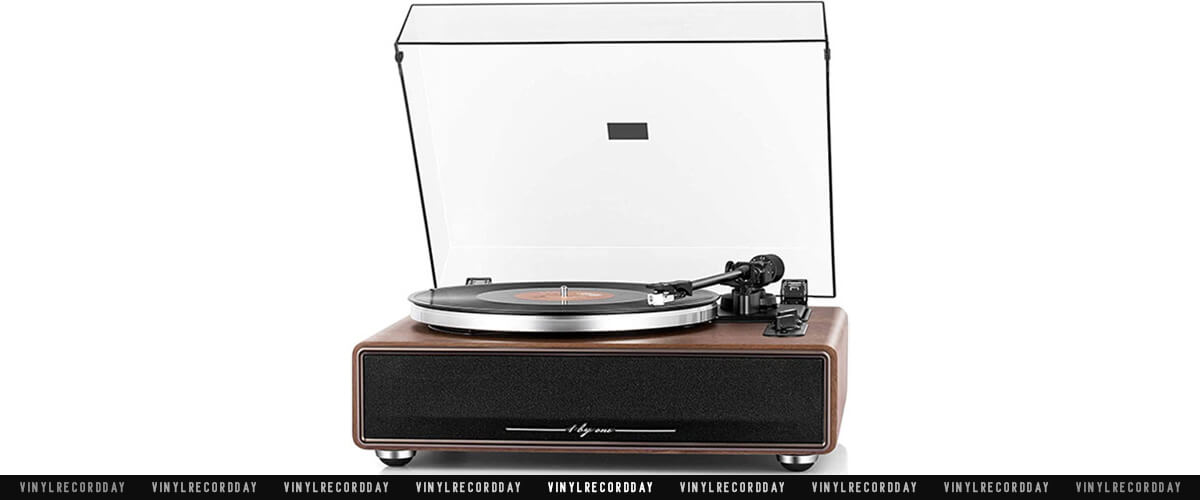
Are you a beginner looking for the easiest and most affordable way to get into vinyl? Then, take a closer look at the convenient multi-functional turntable – the 1byone H009!
This model looks retro but sleek. I must admit, it’s quite well-constructed and feels durable, which is surprising, considering its price. The player is not so bulky as Electrohome Kingston 7-in-1, though it lacks all those bells and whistles the latter boasts.
This belt-drive TT has good-quality components. I appreciated its diamond-tipped Audio-Technica cartridge with an adjustable counterweight. However, the counterweight was slightly off and required additional calibration – that’s a gripe for beginners.
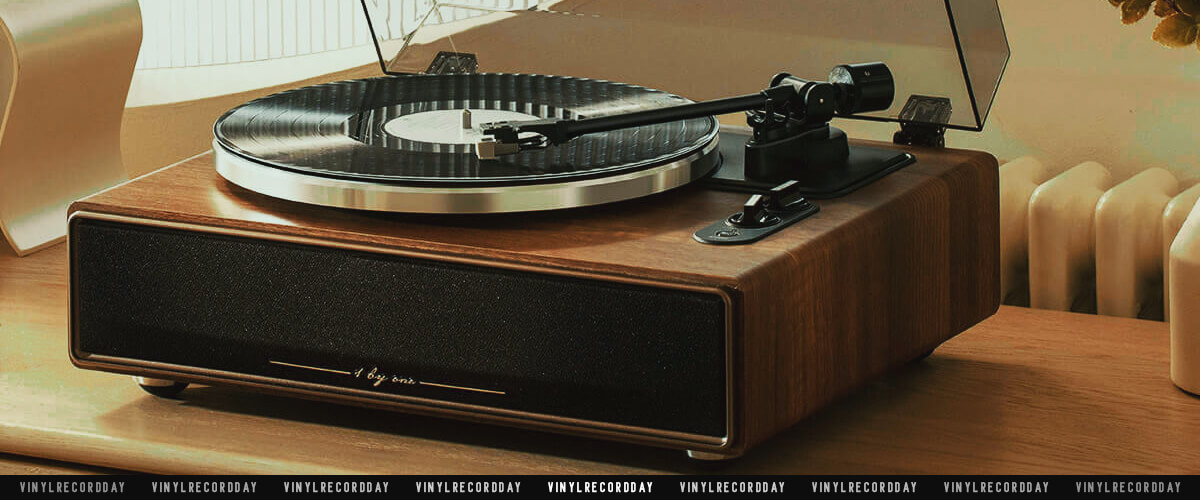
The H009 includes a built-in phono preamp that allows you to connect it straight through to an audio device or amplifier without purchasing any extra equipment or making costly modifications.
The speakers on the 1byone H004 didn’t really do it for me. They sounded okay, but I got the feeling the makers had to compromise on the sound quality. Probably to stop those low frequencies from making the turntable shake and causing records to skip. So, I hooked up some external speakers, and wow, what a game-changer! It’s a good thing this turntable is super easy to connect with its self-grounding and handy line-out.
Oh, and the platter mat it came with? Just a flimsy felt thing. Swapping it out for a better one made a great difference.
But in general, the system has everything you need in one package! Just plug it in, select the desired speed manually via the easy-to-use power button, or let it do all the work by selecting an auto mode for optimum performance without breaking a sweat.
1byone H009 is a decent, affordable record player with built-in speakers. You can hardly find such top-class components in other turntables in a similar price range! The only reason why I put this player after Electrohome Kingston 7-in-1 is because it’s not that feature-rich. So, if you need a basic, inexpensive, yet good turntable, the H009 will be the right choice for you.
Key specs
- Drive type: belt.
- Operation type: fully-manual.
- Speeds, RPM: 33 1/3, 45.
- Speakers power, W: 36.
- Cartridge: Audio-Technica MM.
- Built-in preamp: yes.
- Bluetooth: yes.
- USB: yes.
- AUX: yes.
Pros
- Sleek, compact design – fits into any room.
- Belt drive with built-in speakers for completely self-contained audio.
- Excellent sound quality – the speaker does not over-vibrate at max volume.
- Straightforward setup.
Cons
- Lots of plastic elements.
- A bit challenging setup.
- You might need to spend extra time fine-tuning the counterweight to get things right.
Record player with speakers buying guide
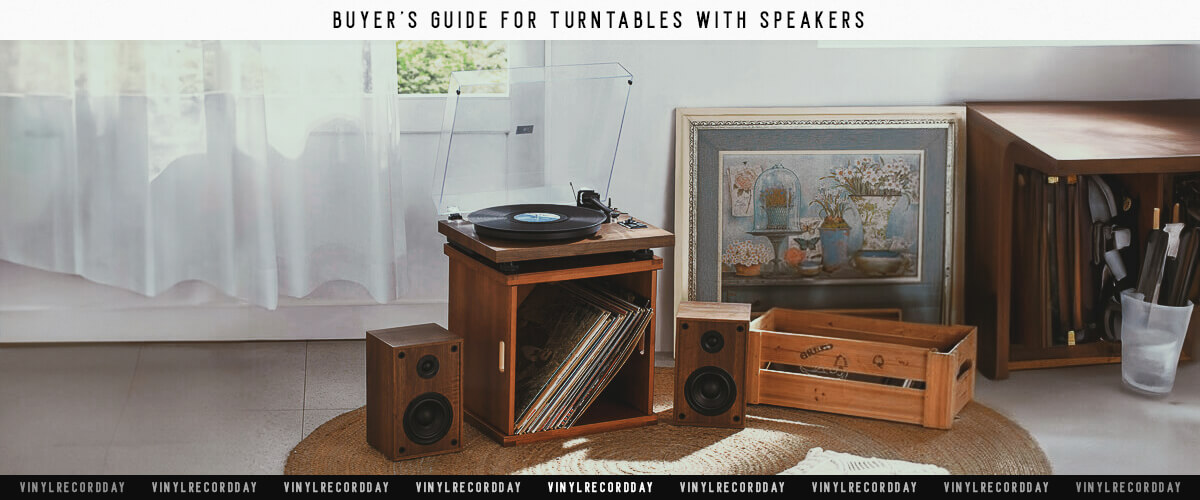
How to choose the right turntable?
There are several factors that you should keep in mind when trying to find a good vinyl record player with speakers:
- Belt-driven vs. direct-driven system – the belt-driven turntable offers better sound quality because the belt absorbs vibration from the motor; however, such a system is usually quite expensive. A direct-drive player features greater torque and faster start times, but it can produce more noise and vibration than a belt-driven model.
- System type – pick a completely automatic or semi-automatic system if you’re an entry-level user. These systems are more technologically advanced, making them easier to operate. In hand-controlled systems, all activities must be performed by hand, which may be inconvenient. If sound quality is essential to you, though, a manual player is a way to go.
- Turntable speed – it’s optimal if the player has three speeds: 33, 45, and 78 RPM – you’ll be able to play any vinyl format with it.
- Additional features – Bluetooth and USB – with the help of Bluetooth, you can stream music to headphones, speakers, and a soundbar, whereas USB helps convert vinyl records to digital forms.
Is it worth having a record player with speakers?
Longtime vinyl lovers will claim you should purchase a high-end turntable and separate speakers bathed in advanced modern technology. Undoubtedly, such products deliver superb sound quality! But on the other hand, these hi-fi systems cost a fortune, and if you are a beginner in vinyl, it’s not a good idea for you!
Good news for you: all record players from my list provide good sound quality enough for entry-level and casual vinyl listeners.
How do I stop my record player humming?
As anyone who has ever tried to play a record knows, the last thing you want is to start a table humming. Not only is it incredibly frustrating, but it can also damage your records.
So, how do you stop your TT from humming? First, check to see if the table’s ground wire is working properly. Next, make sure that the amp and preamp are both connected to the same power board. This will ensure that they are getting a smooth power supply. After that, check to see whether all of the cables are tightly connected. Finally, if all else fails, it could be that the cartridge is faulty and needs to be replaced.
Why are my records skipping?
There are a few things that could be causing your records to skip.
Firstly, your record player’s needle is dirty and needs to be cleaned. Secondly, there may be too much dust or dirt in the air and it is getting caught between the record and the needle, causing the records to skip. You can try to clean the needle and reduce the amount of dust in the air by using a vacuum cleaner or an air compressor. Thirdly, make sure the tonearm is properly balanced. If the weight is too low, the stylus may slip down the grooves on your record, bouncing the sound. On the other hand, if the weight is too high, the stylus presses too forcefully into the grooves, distorting the audio. Both situations might potentially damage your LP.
How do you connect a turntable to a Bluetooth speaker?
Connect your turntable to the same wireless network as the speaker. Then, open the settings of your Bluetooth speaker and go to “Sound Settings” or “Audio Settings.” Next, find your turntable, select it and press the right arrow on the Bluetooth icon. The last step is turning on Bluetooth on your turntable. You will then be able to play music from any audio source through your speakers.
What turntables with speakers did we also test?
In my tests, the Crosley T150B and Victrola 8 in 1 were considered but didn’t make the final cut. Both had notable issues with sound quality, stability, and functionality.
Crosley T150B
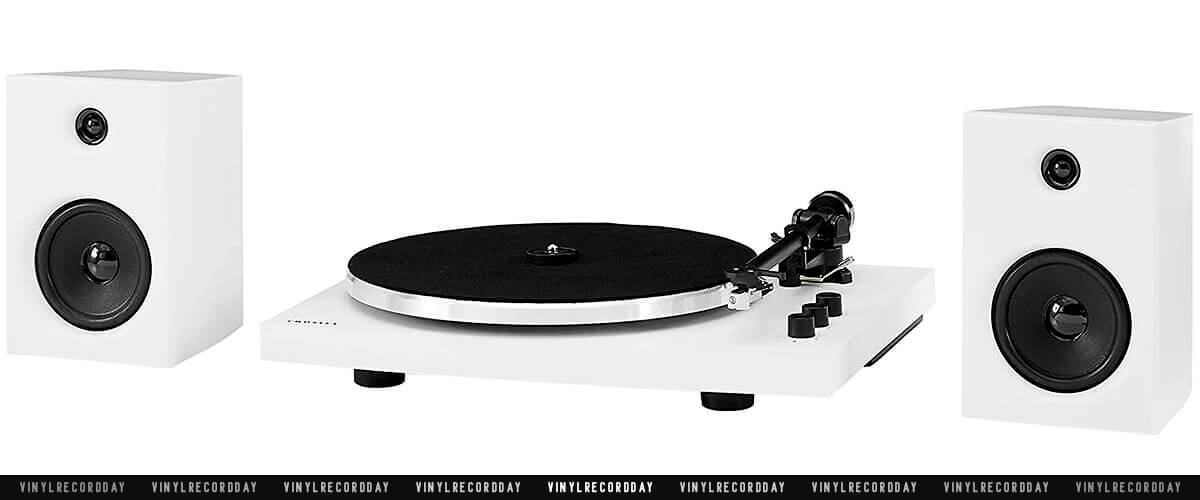
The Crosley T150B, with its external speakers, seems more like a child’s introduction to vinyl than a serious choice. My ten-year-old enjoyed it, but its lightweight, hollow plastic base and arm that tends to slide across records are drawbacks. The 45RPM setting is unreliable, and the player lacks a lid. I’d say it’s a basic, entry-level TT with significant limitations.
Victrola 8 in 1
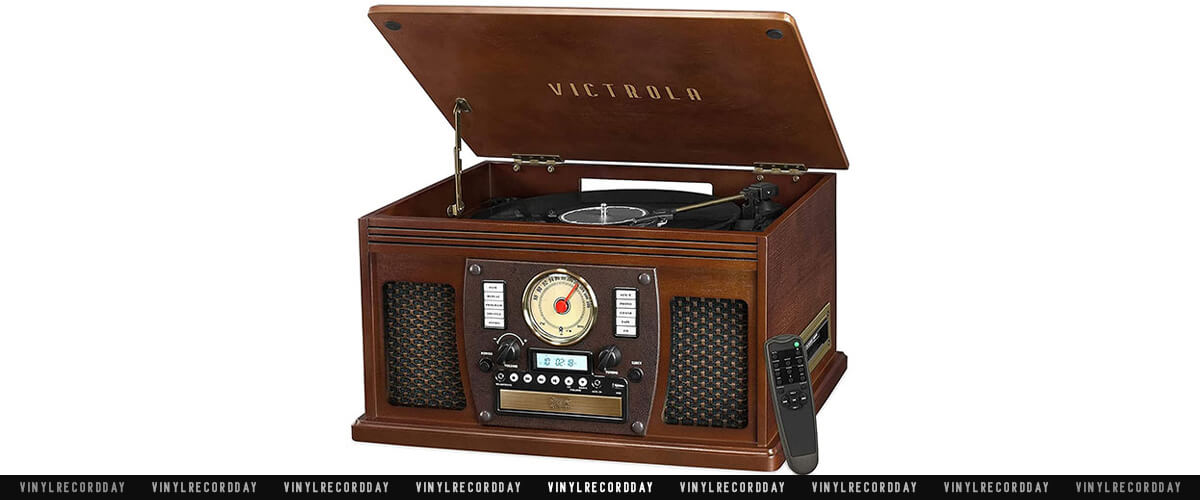
I was initially charmed by the Victrola 8 in 1’s beautiful retro design, but its performance left much to be desired. The speaker quality is poor, with a constant hiss and occasional crackles, even at low volumes. I’ve also noticed it often skips through records, which is frustrating. Plus, its radio functionality is flawed, as it tends to pick up multiple frequencies on the same station, making for a rather disjointed listening experience.
